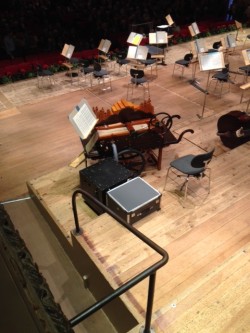 Switzerland Widmann & Bruckner: Tonhalle Orchestra, Michael Sanderling (conductor), Sergei Nakariakov (trumpet), Tonhalle, Zurich, 31.3.16. (JR)
Switzerland Widmann & Bruckner: Tonhalle Orchestra, Michael Sanderling (conductor), Sergei Nakariakov (trumpet), Tonhalle, Zurich, 31.3.16. (JR)

Widmann: “ad absurdum” Concert piece for trumpet and orchestra
Bruckner: Symphony No. 4 (“Romantic”)
Experienced Bruckner conductors are now either rather long in the tooth or have moved on to that great cathedral in the sky where Bruckner (and perhaps also the Dream of Gerontius) is played in the lifts as muzak. Thankfully, some of those venerated names have passed on their expertise to their pupils and offspring and Michael Sanderling is a case in point.
But first let’s get an absurdity out of the way: Jörg Widmann’s concert piece “ad absurdum” to be precise, a première for the Tonhalle Orchestra. In the programme Widmann writes that without Sergei Nakariakov the work just wouldn’t exist. He knows of no other trumpeter worldwide who can master double and triple tonguing and circular breathing for such lengths of time. There is only one tempo to the piece: fast and furious. One did indeed marvel at Nakariakov’s virtuosity on the trumpet , when not distracted by shrieks, burps, clatter and insistent bells from the rest of the orchestra. Christian Hartmann’s percussion contributions were praiseworthy and garnered special applause. This was pure Musiktheater and hard work for the orchestra. Sanderling counted the bars dutifully. One oddity was the rather sombre contribution, towards the end of the piece, by a hurdy-gurdy (Drehorgel) which surprisingly was not particularly audible. We were rewarded with Bach’s gentle “Air on a G string” played by Nakariakov on his slightly larger than usual four-valve Flügelhorn. The audience sighed.
Back to Bruckner; like father, like son. Michael Sanderling must have listened frequently to his father Kurt’s massive and magisterial recording of Bruckner’s Fourth, recorded with the Bavarian Radio Symphony Orchestra in 1994 when Sanderling senior was over 80. (He died in 2011 two days short of his 99th birthday). Sanderling junior’s interpretation is virtually identical to his father’s unsurprisingly, though there are differences in detail, but not in style. It’s in the Tintner, Karajan broad and relaxed style rather than the more athletic style such as Dohnanyi’s. Pace is as steady as a rock, crucial in a good Bruckner performance, though this was a slight detriment in the slow movement which then can in part drag.
The brass was magnificent and commanding throughout: special mention for Simon Styles – on tuba – who had his work cut out. Sanderling managed to infuse the quieter sections with an almost mystical quality whilst not holding back on the decibels in the climaxes which come in all four movements, often so loud they made the Tonhalle’s glittering chandeliers vibrate. Christian Hartmann (again) was busy and effective on timpani. The Andante was noteworthy for Sanderling’s insightful detailing. The robust Scherzo was jaunty and the superlative Finale impressed with its muscular strings and brass chorales. This is not perhaps Bruckner’s most sophisticated symphony (if you can use that word for any of his symphonies) but possibly his most immediately enjoyable, and enjoy it we did.
Sanderling thanked all the front row principals and then made his way through the desks to the double bass principals, always a nice touch. A popular conductor then, with audience and orchestra alike, without quirky stage histrionics (I still have nightmarish images of Urbanski on the podium flash through my brain from time to time).
We very much look forward to what is rapidly becoming Sanderling’s annual visit to the Tonhalle.
John Rhodes
